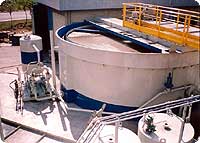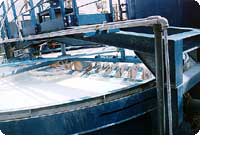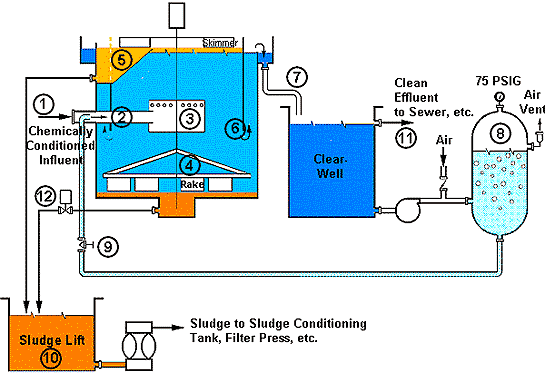



Dissolved Air Flotation Systems
HEI manufactured dissolved air flotation systems (DAF) efficiently separate total suspended solids (TSS) and fats, oils, and grease (FOG) particles from industrial effluents.
Air is dissolved in the treated water by the addition of compressed air to a pressurized stream of recycled effluent. The pressurized water then passes through a pressure relief valve reducing the pressure to atmospheric. This depressurized water is then mixed with the conditioned influent.
As the pressure is reduced, the super-saturated air begins to precipitate from solution. The molecules of air affix themselves or seed to the flocculated solids. The precipitated molecules further coalesce into micro bubbles.
The bubble with the suspended solids and/or minute oil droplets become buoyant and float to the surface. This simple process combined with optimum conditioning chemistry and properly designed equipment provides a sophisticated solids and FOG (fat, oil & grease) separation system.
Extensive Laboratory Evaluation
HEI has performed extensive laboratory evaluation on the size of the air bubble and effective liquid-solid separation. The data overwhelming demonstrate that the smaller the air bubble, the more efficient the separation.
By comparison, the effluent from an induced air flotation system (IAF) typically contains twice as much TSS and FOG as the effluent from a DAF. In the few applications where the reduced separation of the IAF is satisfactory, HEI is able to provide induced air flotation as an alternative. Besides dissolving air into recycle water,
The HEI air dissolve tank also separates and vents excessive macro bubbles from the system subsequently preventing surface disturbance in the DAF tank. Only the pressurized water saturated with dissolved air, not bubbles, is permitted to be commingled with the treated wastewater. Samples from the air dissolve tank have a milky appearance from the microscopic bubble. This HEI dissolved air system is much more effective than an induced air system.
System Design Criteria

There are five important factors to be considered in properly sizing a DAF system:
1. Air to Solids Ratio is the quantity of air required to float a given amount of solids and FOG’s. It usually is expressed as lbs. of air/lb. of solids with the normal ration being between 0.01 and 0.10 lbs air/lb solids. HEI recommends a 0.03 ratio. The amount of air that dissolves in water is determined by the temperature of the recycled water and imposed pressure. Under normal HEI design conditions (75 psig at 70°F) the average amount of air dissolved is 9% by weight. The TSS (total suspended solids) must be analyzed and the appropriate percent recycle rate established. A waste stream of 1000 mg/l TSS will require a recycle rate of 50%, and 2000 mg/l TSS will require 100% recycle.
2. Hydraulic Loading (gpm/ft2) is the relationship between available surface area of the flotation cell and the total flow rate through the DAF influent plus recycle. Hydraulic loading is total flow rate divided by the effective surface separation area. Design hydraulic loading varies from 1.5 to 5.0 gpm/ft2. HEI recommends 2.5 gpm/ft2.
3. Launder Weir Ring Overflow Rate in gpm per linear foot is a convenient-to-calculate value that can be assumed to reflect eddy current formation that would carry solids or FOG under the underflow baffle. It must not be so rapid as to entrain precipitated solids. The overflow must be completely uniform across the launder weir (and thus under the baffle).
HEI recommends the circular DAF design to reduce the launder weir overflow rate. The DAF influent enters through a central mixing well (“distributor”) and flow out horizontally through ports. The bubbles attached to the TSS and FOG float to the surface. The cleaned water flows down under a baffle and over the launder weir.
This radial outflow design dramatically reduces internal velocity and eddy currents, which assures complete separation of the buoyant flocculated particles. HEI does not normally recommend the rectangular designed DAF unit because the high velocity at the inlet is never reduced. Hence, the expected separation is not as efficient in the rectangular design as can be expected in the circular design DAF’s. HEI utilizes the rectangular design for customers with limited available space.
4. Solids Loading is the relationship between the effective surface area of the DAF cell and the total amount of TSS & FOG entering the system. The average design load is 1.0 to 3.5 lbs./hr/sq. ft. HEI recommends not exceeding 2.0 lb. / hr / sq. ft. The calculation should include not only the influent TSS but also all chemicals added to condition and flocculate the waste stream.
5. Solids Removal of both float and sediment (if any) must also be considered in the general design. In addition to the skimming rake to remove the float, HEI also has a bottom rake to sweep any sediment to the center bottom outlet.
HEI dissolved air flotation systems are very effective in the removal of suspended solids and free FOG. Emulsified oil and grease must be chemically conditioned before removal. Due to “van der Waals” charges, particles in industrial wastewater usually exist as a colloidal suspension.
These charges must be neutralized before the solids can be flocculated and floated. The small, destabilized colloids collect and agglomerate with the long chained polyelectrolyte into large floccules which can be rapidly floated to the surface.
Influent Mixing Tubes
The conditioned and flocculated influent is conveyed to the center distribution well through a large mixing tube. The pressurized recycle water saturated with air is added to the treated water through HEI’s proprietary mixing nozzle which induces mild turbulence throughout the mixing tube. The pressure of the recycle water is reduced to atmospheric at the pressure control valve. HEI’s mixing nozzle uniformly blends the air saturated recycled water with the conditioned influent as the dissolved air precipitates from solution.
Central Mixing/Distribution
The depressurized recycle water with the conditioned influent flows into the central distribution/mixing well. The distribution chamber is designed to retain the mixture and provide gentle hydraulic mixing for a short commingling period. Adequate time is permitted for the precipitated air molecules to seed the suspended solids and agglomerate to produce buoyancy.
Other micro-bubbles get trapped inside the pores of the flocs, which certainly would not happen with larger bubbles. The wastewater flows out near the top of the mixing well through distribution orifices to uniformly distribute the treated water throughout the DAF cell.
Float Removal and Sediment Removal
Heavy solids, if any, settle on the bottom of the DAF tank. A bottom rake drive prohibits solids from rat-holing (which is a common problem with cone-bottom tanks without rakes) by continually moving the collected solids to a center outlet. Heavy solids removal is controlled by an automatic valve and may be either automatically or manually initiated. A surface skimmer moves the buoyant solids over a beach weir and flow by gravity to a lift tank.
DAF Cell
The flow rate dramatically slows as it radially moves from the center of the DAF cell to its circumference. Adequate time is provided for the buoyant suspended solids to rise to the surface, forming a float or scum blanket, as the clarified liquid moves radially downward to the outlet baffle. The treated water flows under an outlet baffle up through exit plenum and over the flow equalizing launder weir.
Outlet Chamber
The treated water flows over the launder ring, to the overflow weir, and then to the clear well. A predetermined portion of the treated water is recycled and the remainder gravity flows to the industrial drain or to further treatment.
Pressurization Unit
A portion of the treated water is utilized to provide the media to deliver the dissolved air to the DAF by pumping into a pressure tank with compressed air at 75 psig. Drawing air into a pump suction is not recommended by HEI because the inherent pump cavitation dramatically shortens the life of the high pressure centrifugal pump. The liquid level in the pressure tank is controlled by the HEI special level control that vents all undissolved air (large bubbles) to prevent their entering the DAF separation chamber.
The pressurized water and compressed air are mixed and held long enough to create a saturated solution. The saturated recycle water passed through HEI’s unique pressure reduction valve as it enters the mixing tube. When the pressure is relived, the saturated solution becomes super-saturated and the air begins to precipitate from solution.
Materials of Construction
The HEI standard material of construction is ¼” A36 steel plate, sand-blasted to a SPC-6 finish and coated with immersion grade acid resistant epoxy paint. Stainless steel may be substituted as an option. A NEMA 12 central control panel is provided to control the entire operation.
Industrial Applications
- Aircraft Maintenance and Manufacture
- Animal Slaughter Houses
- Ballast Water Treatment
- Biological Sludge
- Chicken Processing Plant
- Cosmetics Manufacture
- Industrial Laundries
- Metal Removal
- Oilfield Produced Water
- Oil Refinery
- Pulp and Paper
- Seafood Processors
- Tank Truck Cleaning
Turn-Key Design
HEI will provide the entire turn-key DAF system to include engineering, lift station, chemical conditioning, solids compaction, installation and start-up. HEI engineers and manufactures its own equipment and will provide individual items of equipment for complete turn-key plants.
dissolved air flotation systems, daf, environmental treatment system, suspended solids, biochemical oxygen demand, oils and greases, daf effluent, recycle stream, remove biological solids, sludge solids, aerobic biomass, activated sludge,


